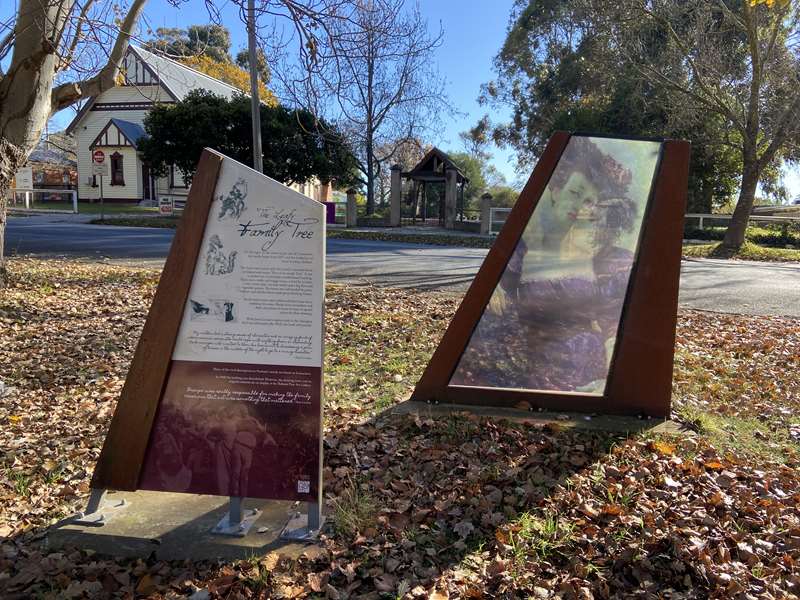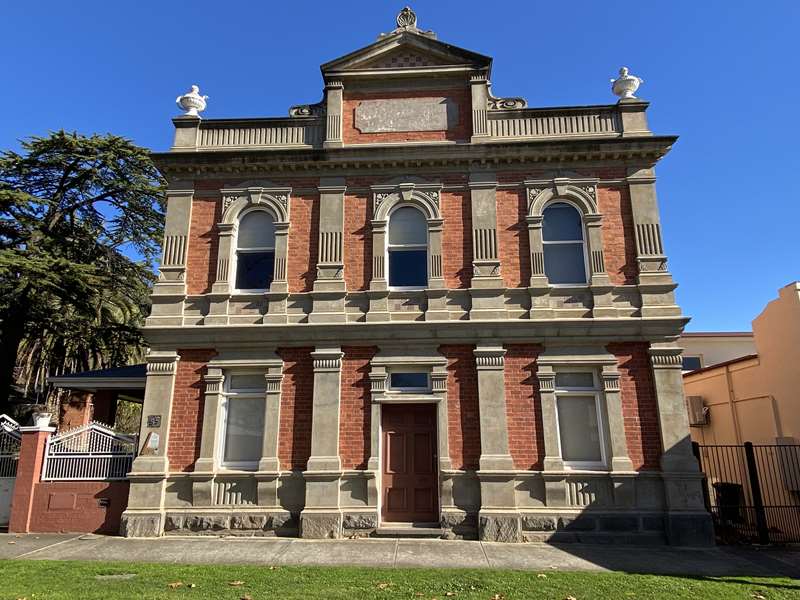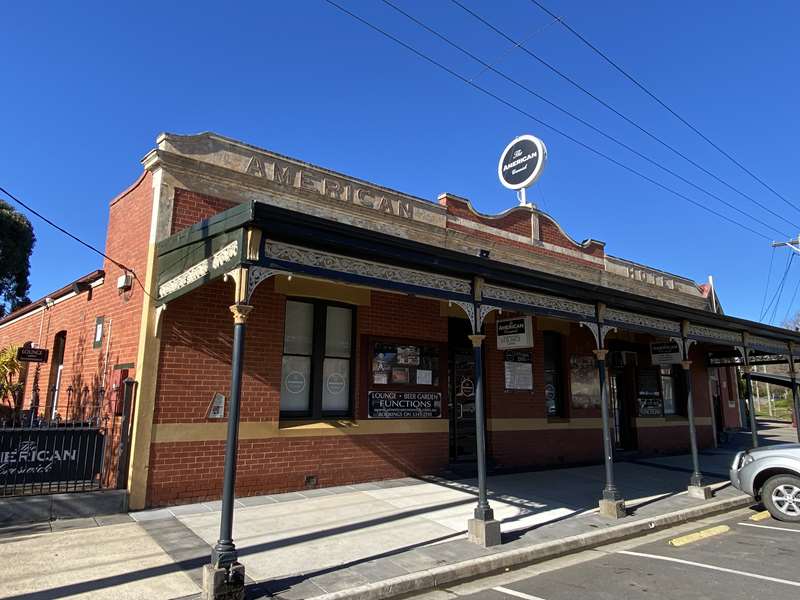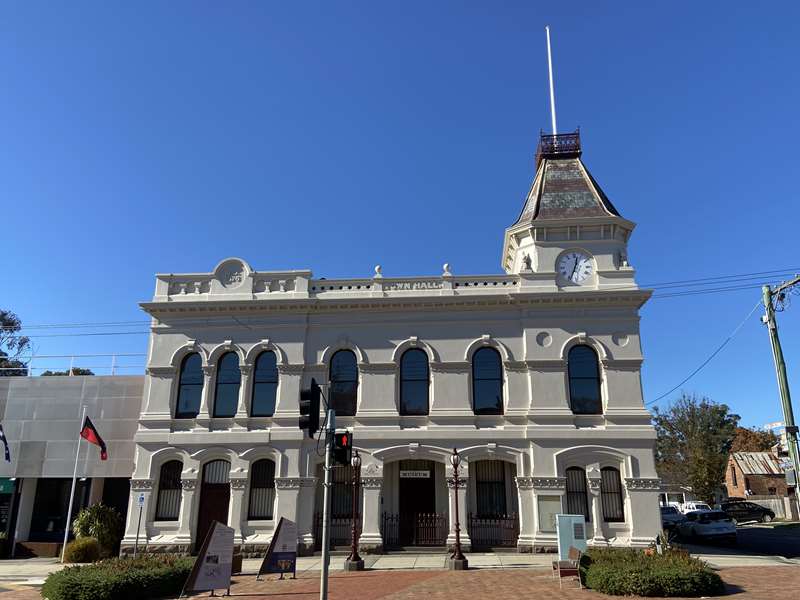Creswick of The Lindsays Art Trail

Creswick was the birthplace and home for the Lindsay family, many members of which achieved fame and notoriety in the field of the arts.
Norman Lindsay was a famous painter, and also wrote 11 comic novels, and illustrated 30 other books. Sir Lionel Lindsay was a printmaker; Sir Daryl Lindsay was director of the National Gallery of Victoria and a water colourist; Ruby Lindsay was an illustrator; and Percy Lindsay was both a painter and a distinguished art teacher.
The Arts Trail highlights the sites and buildings in Creswick that have significance to the Lindsay family. At each site there is a description explaining why each site was important to the family. Many include QR codes, allowing you to access further information on your mobile device.
The best place to start the trail is at the Visitor Information Centre at the corner of Victoria Street and Albert Street, although you can join it at any site you choose.
This guide contains a map, with each site numbered from 1 to 24. Most of them can be reached with an easy walk, but some - such as the cemetery - are best visited by car. The total distance of the trail is 7.3 km. However you choose to travel, enjoy the journey.
This guide can also be obtained from the Creswick Visitor Information Centre.
Map Showing All Locations

Map Showing Central Locations

1. VISITOR INFORMATION CENTRE
Here you will find the background story to the whole Lindsay family, whose father was attracted to Creswick by the discovery of gold. You can find details of the five famous children, as well as information about their lesser known relatives. The famous five are Norman - the brilliant one, Lionel - the print maker and art scholar, Daryl - the cultural administrator, Ruby - ravishing and reserved and Percy - the amiable one.
The large glass panel at this site features a portion of a Norman Lindsay painting, titled The Amazons.
2. THE LINDSAYS' SECOND FAMILY HOME

was on the corner of Victoria and Cambridge Streets in Creswick. 'Lisnacrieve' was the family home from 1877 and the birthplace of seven Lindsay children. The house was named after the family's ancestral home in Ireland and means "Fort of the Leafy Tree". It was a modest but comfortable weatherboard building. There was a stable and buggy house, a shed for poultry, a 'two-seater dyke' (outside toilet) and a big fruit and vegetable garden. The house was surrounded by pines, willows and old firs which made great climbing frames.
Inside extra rooms were added until the house was a rambling 16 rooms. Books were everywhere and there was plenty of room for boys to sprawl across the floor drawing. With Jane Lindsay's explicit faith in the Almighty she'd say philosophically: Well, the Lord will provide. The house was demolished in 1968.
There is a photograph of the former home on a stone cairn in front of the site. A re-creation of the drawing room can be seen at the Ballarat Art Gallery.
3. THE FORMER WESLEYAN CHURCH SITE
The Lindsay children's grandfather, the Reverend Thomas Williams, was the minister here from 1863 to 1866. He was an unusual mixture of passion and Puritanism. The Lichgate contains panels describing Williams' influence on the children's artistic aspirations and religious views.
The church which once stood here was built in 1861 and demolished in 1986. The surviving hall and parsonage are still used as a community centre.
During his time as a missionary in Fiji, Rev Williams had written and illustrated Fiji and the Fijians published in 1858. With his passion for the art and literary culture of Europe, he encouraged his grandchildren's artistic endeavours. The stern Grandpa Williams provided the creative stimulus to the family.
In spite of his support of their artistic explorations, the majority of the Lindsay children rejected the beliefs of their Methodist grandfather. The Reverend had preached here but that was many years before the family moved next door.
Ruby married Will Dyson here on 30th September 1909, A shy young lady, she was so scared by the number of well-wishers outside the family home that she fled back inside. She then went through the house to the backyard, scaled a fence, sneaked through the long grass and arrived at the altar via a side entrance with her veil covered in grass seeds.
4. CRESWICK GRAMMAR SCHOOL
The school was located across the road from this memorial. The school opened in 1869 with less than 30 students. At various times Percy, Robert, Lionel, Norman and Pearl Lindsay were all pupils at the school. Here they published the Boomerang newspaper which Percy began and Lionel continued. It was later revived by Norman. It was printed on a gelatine pad in mauve ink from handwritten sheets. It was sold for a halfpenny and contained essays, poems, original jokes, sporting notices, illustrations and announcements.
5. BRITISH HOTEL

Norman, Lionel and others frequented this and other hotels in the town. Many of their artworks pay homage to the fruit of the vine. You can walk or drive to the next few sites.
6. FORMER CHINESE CAMP
The present day Calembeen Park was once the site of the Black Lead gold diggings, which was occupied by between 3000 and 6000 Chinese miners. The vibrant Chinese community provided a source of fascination and inspiration for the Lindsay boys.
The Chinese camp was a place of curiosity and adventure for the Lindsay children. Along with other small boys they would call the miners names, play tricks on them and even pelt them with stones. Such racist behaviour was a reflection of the time which later was regretted.
This location was once the famous Black Lead diggings. At the height of the boom in the 1850s between three and six thousand Chinese miners lived here. Shops, opium dens, joss houses and shacks were arranged along two streets. The miners reworked abandoned mines, extracting every speck of gold. Most hoped to return, wealthy, to their country and families. While here they continued many of their own cultural customs.
Chinese theatre groups were extremely popular. They had begun visiting the gold fields shortly after the rush had started. Between 1858 and 1869 some fourteen companies, with up to fifty performers, toured. The miners also grew their own vegetables and many of those who stayed in Australia set up successful market gardens. Creswick's Chinese community contributed considerable money to charitable causes, including the building of the hospital.
The Chinese camp was our Paradise. Here were two joss-houses, from which the burning joss-sticks could be looted, and here lived a wizened old Chow called Sinkum who would match his inimitable (peanut toffee) against our pennies. At the entry of the Chinese camp stood the dwelling of Ginger Mary Ann, a bedraggled representative of the oldest profession on earth...and sometimes we would see the ginger beer maker. But our business was with Sinkum the toffee-maker, and we debated the inevitable alternative - should we toss or buy? - Lionel Lindsay
Around the turn of the 20th century, most of the Chinese camp was displaced by the Black Lead Hydraulic Sluicing Company. The huge hole created by its mining operations became the present Calembeen Park swimming basin.
7. THE GULLY
between Raglan and Victoria Streets was a favourite hiding place when the Lindsay boys wagged school - a frequent occurrence, apparently.
When Norman wanted to wag school he often hid here. It provided a concealed track to another favourite place - the Chinese camp down the road. He played truant from the State School as often as he could, sometimes hiding in the family stables where he taught cats to walk a tightrope. Once he managed to wag school for six whole months...
His education was provided as much by the world around him in the humpies and exotic culture as it was by the books at home. For him learning was not found in the classroom. Later he wrote of his boyhood in the novels Saturdee, Halfway to Anywhere and Redheap. In the tradition of Mark Twain's Torn Sawyer, these stories are about the comic antics of boys.
8. THE CRESWICK RAILWAY STATION
Then as now, the train to Melbourne provided a link to the city and to the bohemian community of writers and artists that was developing there at the time.
9. THE STATE SCHOOL
The Lindsay children attended at least for some of their education. They used to to complain about the dreariness of school life. They all found a far richer knowledge could be gained by the books at home and in amongst the humpies, hillocks and people of Creswick.
The Education Act of 1872 made education 'free, compulsory and secular'. The Creswick Primary School, built in 1874, was attended by most of the Lindsay children before moving on to the Grammar School. The girls were mostly schooled at home by governesses. Discipline was strict and corporal punishment was part of everyday life. Often administered by sadistic male teachers it was considered character building. None of the Lindsay lads avoided the cane.
Across from the school is the Magic Pudding Playground, named after Norman Lindsay's beloved children's book. It features some of the characters and settings mentioned in it.
First published in 1918, The Magic Pudding has never been out of print and is one of the classics of Australian children's literature. Lindsay wrote the story to settle a bet that children preferred food to fairies. Even though, in later life he called it a 'little bundle of piffle` the charm of the story and his illustrations continue to delight us.
10. NAPIER STREET
This is the approximate location from where Percy Lindsay painted a scene of Creswick in 1892. The painting is now in the Art Gallery of Ballarat. A comparison between it and the current view demonstrates how little things have changed over more than a century. Gone are the ducks and hens and the tranquil rural scenery, but the bridge on the left, the spire of St Augustine's Church and the side street on the right can still be seen.
11. PERCY LINDSAY'S PAINTING
It was near here that Percy Lindsay painted one of his best known paintings, 'The Girl in the Red Dress' (1894) featuring his sister Pearl, described by Daryl as a 'cheerful happy-go-lucky girl'. You can wander down the rural lane way that loops behind the main street. You may see the exact view depicted in the painting. The painting now hangs in the Art Gallery of Ballarat.
In 1909 Pearl married Colin McPhee, a chemist and metallurgist and manager of two gold sluicing dredges in Creswick. He died in 1915 leaving three children for Pearl to raise. She lived with her family at 'Lisnacrieve' for some time before moving to Ballarat.
12. THE OLD AUSTRALASIA BANK
In the 1880s the bank manager, himself a talented watercolourist, encouraged Percy Lindsay's interest in art.
Samuel Albert Edmonds arrived in Creswick as manager of the Bank of Australasia. A talented watercolour artist, he immediately set up a studio at the back of the bank. He was soon familiar with the Lindsay family and encouraged Percy's interest in art. The two went painting together. Edmonds invited painters such as Walter Withers and John Marshall Hall to stay with him and during these visits they conducted classes at the School of Mines. The Bank of Australasia was established in 1835 and eventually became the ANZ Bank
13. THE FORMER SCHOOL OF MINES

Percy and Lionel Lindsay attended art classes and Percy went on to teach here.
14. & 15. LIBRARY AND POST OFFICE (FORMER)
.jpg)
This site on a prominent corner in Creswick was significant to the Lindsay's through access to the library and through the contact that letter writing provided to all family members. For Mary Lindsay, letter writing was the only outlet she had for a talent which may well have been equal to her brothers.
It was in the library that Lionel discovered a book on astronomy which led to his leaving Creswick to study at the Observatory in Melbourne. And it was here that Norman found a book of engravings by Albrecht Durer, a source of early inspiration for him.
16. THE LINDSAY FAMILY
had a rich engagement with WWI. Brother Reg's name appears on the war memorial. Reg was killed on 31st December 1916 during the battle for the Somme. Daryl enlisted in 1915. In 1917 he became batman to war artist Will Dyson and sketched diggers on the battlefields of Northern France. He later became the official medical artist at Sidcup hospital (UK) where they were pioneering facial reconstruction.
17. FIRST LINDSAY FAMILY HOME
on the corner of Raglan and Cambridge Streets. The family lived here from 1869 to 1877. Percy, Robert and Lionel were born in the original house which became too small for the growing family and they built 'Lisnacrieve'. Although still called Fovant, the house you see was built later in 1912.
18. AMERICAN HOTEL

This hotel was one of many frequented by the Lindsays. Lionel Lindsay describes the American Hotel as 'a way of escape, for here was hearty company, good bawdy humour and the artificial paradise, envy of the puritan.'
It has a dedicated Lindsay room and a number of reproductions of family paintings.
19. THE CRESWICK ADVERTISER
occupied several buildings over the years. It is thought this was the site at the time the Lindsay boys were publishing their own school newspaper.
Back in 1908 this is how the paper described the Lindsay boys' bold attempt at publishing their school newspaper:
"There are some pictures of Norman Lindsay's which will never be reproduced or hung in public. They represent the corrosive caricatures which he used to draw of his schoolmasters when he was undergoing instruction in Creswick.
The Lindsay boys between them used to run a school paper which was not the least under the official patronage of the headmaster. Several times it was suppressed by sheer force of cane and strong right arm, a whole issue was seized and burned in the schoolroom fireplace, but somehow the libellous publication used to struggle to the light again.
Here and there in Creswick a sinner may still be found chuckling over a tattered copy."
20. TOWN HALL AND CRESWICK MUSEUM

The Town Hall features prominently in the Lindsay family story. It is mentioned in Norman Lindsay's Creswick novels, and was where six of the children took part in a production of "Faust" in 1893. The building now houses the local museum, containing several artworks by Lindsay family members.
21. CRESWICK HUB (LIBRARY)
Norman Lindsay was a prolific writer, and many of his books were set in the town. The plaque on the library wall illustrates some of his book covers, and many of the books themselves remain on the shelves.
22. OLD GOLDFIELDS HOSPITAL
Originally the Creswick Goldfields hospital, Dr Robert Lindsay was honorary medical officer here. The two storey mansion, Tremearne House, was built in 1881.
What is today part of Melbourne University's Forestay School was once Creswick's grand Goldfields Hospital. It was a year old when Dr. Robert Lindsay arrived here in 1864, fresh from his studies in Belfast and Edinburgh, and he had a long association with the hospital as an honorary medical officer.
The two storey house here was once Tremearne House, built in 1881 by the resident medical officer, Dr John Tremearne. In 1909 it was acquired by the State Forests Department for a School of Forestry and the first students attended here in 1910-1912. Among the 'first six' was Reginald Lindsay. Dr Lindsay's sixth son.
Dr Robert Lindsay was one of the town's doctors. He married 19 year old Jane Williams, whose missionary father had come to Creswick to take up the post at the Wesleyan Church, in 1861. Jane was an extremely capable person and frequently assisted her husband in medical emergencies often the result of accidents on the goldfields.
23. THE LAKE

The picturesque Park Lake was created in 1888. Park Lake was the scene of adolescent trysts for the Lindsay lads in both fact and fiction. It was a place where the strict class structure disappeared, as casual affairs with shop assistants, domestic servants and daughters of miners were possible. Without extreme discretion, it was not possible to trifle with the daughters of family friends.
In Norman's novel, Redheap, the bushes of Park Lake are the scene of Robert's affair with the parson's daughter, Millie. The youthful Norman admired Lionel's exploits in Creswick and later admitted he had based Robert and Bill amble in Saturdee on Lionel.
24. CRESWICK CEMETERY
Seven members of the Lindsay family lie here.
Photos:
Location
Cnr Victoria Street and Albert Street, Creswick 3363 View Map
Web Links
→ Creswick of The Lindsays Art Trail Map (PDF)









